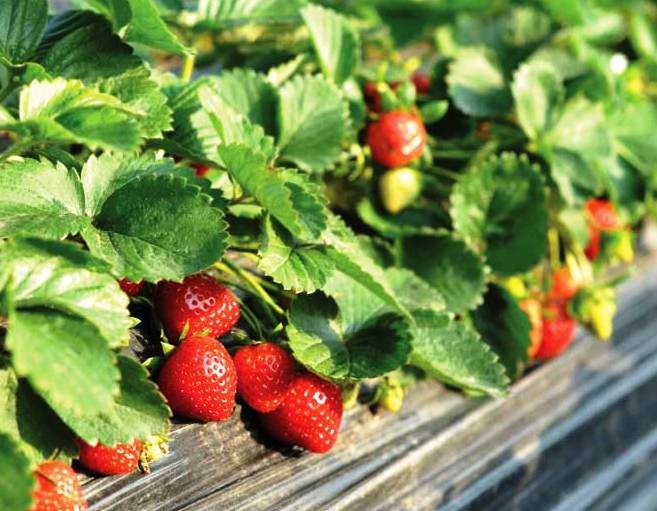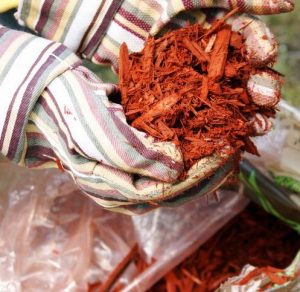by Ken Lain, the mountain gardener
Planting a strawberry bed can be an intimidating prospect. But fear not, these mountain-hardy tips will give you a good start to a successful harvest of luscious berries. It’s not quite as easy as plopping a plant in the ground and hoping for the best, but follow these easy steps and you just might become a strawberry garden expert.

- Prepare the Site – Start off with a weed-free site; it will save you a lot of energy and effort later in the season. Once the weeds are gone spread a 2-3” layer composed of 50% Watters Premuim Mulch and 50% Barnyard Manure over the bed. No need to work these organics into the soil. Some will be worked in when your plants are put into the ground and some will get moved by earthworms. Strawberry plants are shallow rooted and need their nutrients near their soil’s surface.
- Choose the Right Variety – There are 4 basic types of strawberries: June bearing, day neutral, ever-bearing, and the tiny, but delicious, alpine strawberries. If you want to preserve strawberries, June bearing produces the largest crop at one time.
If you want to enjoy your strawberries over the entire growing season then choose day neutral or ever-bearing. Day neutral berries produce multiple small crops throughout the season. Ever-bearing are misnamed; I find that they produce 2-3 crops per season, which are a little smaller in yield than the June bearing.
Ideally, plant some of both June bearing and day neutral and you’ll have berries for whatever your needs.
- Some are Better than Others – Strawberries are susceptible to a handful of fungal diseases. Do your homework about these challenges or visit the strawberry experts here at Watters Garden Center. We have curated the very best varieties for mountain gardens.
Best to plant strawberries away from tomatoes, peppers, potatoes, and eggplants as these common garden residents share some of the same diseases as strawberries. Keep these crops separate and clean for best results.
- Plant Enough – Each strawberry plant should yield from 1 cup to 1 pint of fruit per season. Keep in mind that June bearers will produce their yield during the course of 1 month; the other types will spread their bounties out over the entire growing season.
- Why They’re Called Strawberries
 Mulching is essential when growing strawberries. A thick layer of soft mulch does more than inhibit weeds and conserve water. It also keeps roots cool, which strawberries like, and it keeps the fruits off the ground where they can fall prey to insects and pathogens. Straw has long been the material of choice; hence, the berry’s name!
Mulching is essential when growing strawberries. A thick layer of soft mulch does more than inhibit weeds and conserve water. It also keeps roots cool, which strawberries like, and it keeps the fruits off the ground where they can fall prey to insects and pathogens. Straw has long been the material of choice; hence, the berry’s name!
If you don’t like the look of straw, consider shredded cedar bark, shredded leaves, or pine needles.
- Watch for Snails and Slugs – We are not the only animals to love strawberries. There are many pests to be aware of, but snails and slugs are the most voracious. Watch for signs of their nibbling and take action quickly. We at Watters have hand selected an organic bait that not only eliminates snails and slugs, but also takes care of pillbugs/pill bugs and earwigs. It really takes the fear out of strawberry predators. Now, if it only worked on repelling birds! Guess that’s why we have bird netting and scare tape, eh?
- Water Wisely – Strawberries need about 1 inch of water per week from March through October. The two most important times for regular water are at planting and when the fruits are forming.
These tips are relatively easy for in-ground plants and raised beds. For an even easier strawberry experience simply fill your favorite container with Watters Potting Soil and plant your strawberries. Because this professional grade potting soil ignites new growth and many fruits, you’ll be amazed at how many fruits can be harvested from a small space!
Until next month, I’ll see you here at Watters Garden Center.
Ken Lain can be found throughout the week at Watters Garden Center, 1815 W. Iron Springs Rd in Prescott, or contacted through his website at WattersGardenCenter.com or FB.com/WattersGardenCenter .

